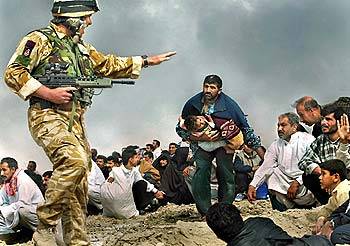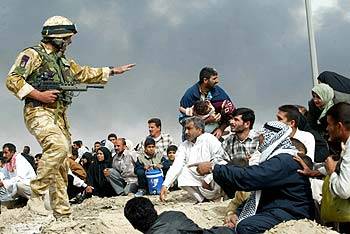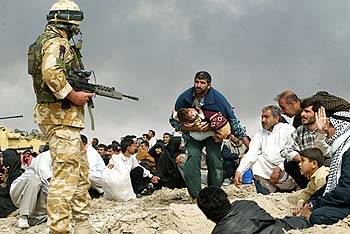
The above photo from the LA Times has led to the dismissal of the photographer involved. It turns out that it's Photoshopped, created by combining two different images:


The LA Times
has admitted what happened and fired the photographer. It's all a little bit amazing when you consider that he did it all in southern Iraq, but laptops have been capable of running Photoshop for some time now, and every digital photographer probably transfers images from their cameras to their laptops in order to send the images home.
This had been a front-page photo, but a careful eye will find the falsification. For example, if you look closely, you'll notice that there are a couple of guys in the photo who wind up duplicated. In the doctored shot, they are both behind the soldier's knee
and in front of it; look for the kneeling man in white, and the head just over his shoulder.
I don't find any motive behind this, other than simply to create a better shot with a stronger composition. But clearly, firing the guy was the right thing to do.
There is an undercurrent running through the war; in the swirling torrents of change, one of the things we see repeatedly is journalists not taking their responsibilities seriously enough. That's partly because the public has not demanded quality journalism all along, but once something truly serious like war comes along, it divides the serious and the non-serious and makes the differences more apparent.
Nobody would have been fired if the photographer had been covering the Oscars and had Photoshopped the spectacle of arriving actors and actresses. But they should have been.
We hate war partly because it is deadly serious and focuses us in uncomfortable ways, bringing about quick change. It
exposes people like Peter Arnett, Geraldo, LA Times photographers and
Columbia University professors as the non-serious types they are. But, at the same time, reminding us what is truly important and refocusing us is a good thing.
more detail on the firing
An LGF commenter details the probable changes:
The camo on the thigh has been enhanced (history brush on multiply), there is more detail in the boot (same technique), the face has been lightened (apply image on screen or history brush on screen or dodge tool), his shoulder-patch is sharper (unsharp mask). I couldn't be absolutely certain but the thought ocurred to me that he might have widened his upper upper body just a teenie bit with free transform. Just a smidge. Maybe I'm seeing things.
And the soldier has been made larger and put closer to the viewer so that he takes up more space. This photographer did not just cut the soldier out and paste him in the other picture. He spent some time at this. An hour or 2.